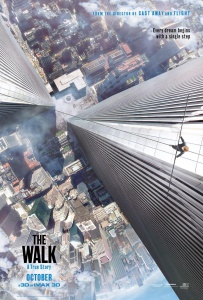 There have been reports that people have vomited after witnessing the tight rope sequence across the World Trade Center towers in Robert Zemeckis’s film “The Walk”. The fact is it’s a bad trigger for Vertigo sufferers, but the scene itself is not made to be a thrilling stunt. It actually slows the film, away from the madcap whimsy of Zemeckis’s biopic and to something a little more peaceful, tranquil and spiritual.
There have been reports that people have vomited after witnessing the tight rope sequence across the World Trade Center towers in Robert Zemeckis’s film “The Walk”. The fact is it’s a bad trigger for Vertigo sufferers, but the scene itself is not made to be a thrilling stunt. It actually slows the film, away from the madcap whimsy of Zemeckis’s biopic and to something a little more peaceful, tranquil and spiritual.
And yet for all the CGI wizardry and IMAX, 3D spectacle for which “The Walk” is earning its buzz, Zemeckis never manages a moment as beautifully weightless as James Marsh does with just still images and Erik Satie’s “Gymnopedie No. 1” in the Oscar winning documentary “Man on Wire”. “The Walk” is weighed down not only by its storytelling building up to the walk but in its spectacle.
Philippe Petit managed a daring stunt upon the completion of the World Trade Center towers in New York by dangling a wire across the 140 feet of the two buildings and walking across, 110 stories off the ground. The performance was a coup, a beautiful demonstration against the law, and the movie charts not only Petit’s madness but the pain and struggle it took to sneak past the guards to make his art.
Joseph Gordon-Levitt plays Petit, and although he’s not French and doesn’t quite look the part, he’s a spunky song and dance man capable of embodying Petit’s goofy, circus charms and showmanship. He’s also perfectly insufferable, narrating his life story from atop the Statue of Liberty no less, the towers idling in the background as though 9/11 never happened.
It’s the laziest sort of storytelling, in which not only does Zemeckis opt to tell us Petit’s story rather than show us, Gordon-Levitt seems all too eager to do so and lays the whimsy of becoming a wire walker on thick. Gordon-Levitt butts up against the equally galling accent of Ben Kingsley as Petit’s Czech mentor, and the early chapters of the film range from cheesy to grating.
“You’re doing too much,” Kingsley’s character says to Petit about how to be sincere in performance. “Do nothing!” Zemeckis would’ve been good to heed this advice, for as we wait for the 3-D to make itself useful during the walk sequence, Zemeckis throws juggling pins and balls at the camera and has Petit showboat or spin a globe to keep things alive.
Things liven up a bit when Zemeckis switches to caper mode, diving into how Petit spies on the Twin Tower construction crews, builds his team of accomplices, and tries to rig his equipment while avoiding detection. “Man on Wire” did this wonderfully, donning a style that borrowed from Errol Morris but had energy all its own. “The Walk” suffers from a few stock characters like a flaky stoner and some negative nellies constantly telling Petit it’s impossible.
“The Walk” also doesn’t get inside Petit’s art as strongly as “Man on Wire” does. Marsh knew that the artistry of Petit’s act was in the coup, defying the law but in a peaceful, beautiful way. “The Walk” is all about the thrill and spiritual sensation of its major set piece. The camera throughout the movie teases the sensation of staring downward until finally it cranes overhead and sees to infinity. Its movements around Petit are slow and feel treacherous, but only to the extent that we sense each of Petit’s steps and feel comfortable in his shoes.
As James Marsh accepted his Oscar, Petit joined him on stage and said, “Thank you to the Academy for continuing to believe in magic,” performing a slight of hand trick and then balancing Marsh’s Oscar upside down on his chin. It was an unexpected moment of levity that immediately deflated the stuffy airiness from the Oscar ceremony. “The Walk” is a movie that aims to be full of those moments, whimsical and endearing to the point of being insufferable. At least up on that wire he shuts up for a moment.
2 ½ stars